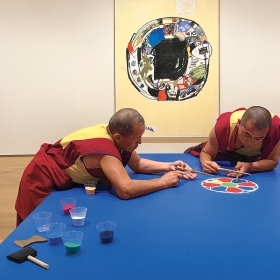Photo by Lachell Workman
Alexandria Smith’s life, like her exuberant collages, is composed of many layers. She’s a mixed-media visual artist, assistant professor of studio art at Wellesley, the co-organizer of the artists’ collective Black Women Artists for Black Lives Matter, and a former art teacher in the New York City schools.
Her art deals with questions of identity, of “trying to figure out who you are,” she says. Earlier in her career, Smith created characters who are young black girls in pigtails and dresses. In a series of paintings and drawings, these cartoonish figures are often shown with a paper sack or pillowcase over their heads. Smith explains that these characters “evoke various psychological states, and at the same time blur the distinction between representation and abstraction.”
The works delve into not only the common experience of being an adolescent, and a girl, but more particularly, being an adolescent girl of color. Smith says that while she drew from her own life, none of the work should be taken as autobiographical. She’s more interested in the complexity and totality of female experience.
A theme that runs throughout her work is the journey of girls becoming women, and how they develop a sense of self and a feeling of empowerment along the way. “I’m trying to highlight multiple aspects of femininity,” she says.
In Smith’s more recent work, the girls in pigtails appear to have grown up. In The Pleasure Principle, a 10-by-40-foot paper and canvas collage, women’s bodies are depicted in full bloom, as they cavort and enjoy themselves every bit as much as the women in Cézanne’s The Bathers. The analogy is intentional: Smith’s compositions often reference historic paintings from the impressionist, Baroque, and Renaissance eras. She’s commenting on the idealized view of (white) women found in paintings throughout history. “I wanted to showcase black and brown figures just being joyful and happy and present and seen,” she says.







We ask that those who engage in Wellesley magazine's online community act with honesty, integrity, and respect. (Remember the honor code, alums?) We reserve the right to remove comments by impersonators or comments that are not civil and relevant to the subject at hand. By posting here, you are permitting Wellesley magazine to edit and republish your comment in all media. Please remember that all posts are public.